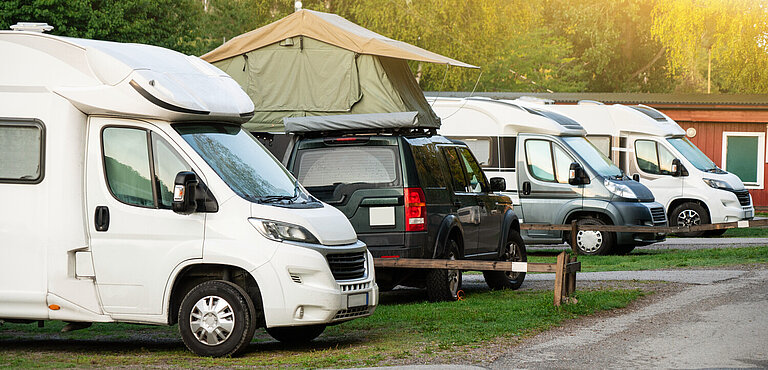Climate Balance of Caravanning

The study determines the emissions and energy consumption of motorhomes and caravans over their service life and over an average year. It also compares typical motorhome or caravan trips with other types of travel. The climate balance takes into account the emissions from the return trip to the destination, on-site mobility and accommodation.
High emissions from the manufacture of motorhomes and caravans
The greenhouse gas emissions from the manufacture and disposal of motor homes are significantly higher than those of the average diesel passenger car (10 t): motorhomes range from 15.2 (vans) to 18.6 t (larger and heavier fully integrated motorhomes),. Together with the emissions from the use phase, the motorhomes emit per year between 3.9 and 4.3 t CO2 eq. for typical use with 10,000 km annual mileage and 82 overnight stays per year.
A caravan has greenhouse gas emissions of 5.6 t CO2eq from its manufacture. Caravans are significantly used less than motorhomes. With this lower utilisation intensity (average annual mileage of 5,100 km and 54 overnight stays), annual emissions of 2 t CO2eq result.
In a travel comparison, caravanning can score due to low emissions for overnight stays
The high emissions from manufacturing and driving (+44% to +58% compared to diesel cars) can be offset by lower emissions from overnight stays: For example, caravan trips are advantageous compared to car trips if they are understood as slow travel, i.e. a two-week trip to the island of Rügen. Emissions from trips with motorhomes and caravans per person can also be reduced by increasing the load factor or by renting the motorhome at the destination while travelling there by public transport.
In particular, caravanning has an advantage when compared to trips that were booming before the COVID 19 pandemic: cruises and long-distance (air) travel. On the other side, travelling by train or long-distance bus is the option with the lowest GHG emissions, regardless of the form of overnight stay. This advantage increases with long distances.
Emission saving potential for caravans and motorhomes
Among motorhomes, vans are the most efficient form of caravan travel, with a difference of about 10 % to the other mobile homes considered. Technical developments such as lightweight construction and electrification also have a significant potential for reducing emissions from these vehicles. The electrification of caravans, which allows the use of electric cars as towing vehicles without any major loss of range, is being discussed in particular. First estimates of the emissions of this combination show savings of about 25 % in operation (with today's electricity mix) compared to the conventionally driven caravan/car combination. For electric caravans the multiple use of components (electric motor, battery) is aimed at, e.g. as a manoeuvring aid/mover or on-board battery, in order to reduce the additional emissions from production by eliminating other components.
Runtime
February 2020 – September 2020
Client
Caravan Industrie Verband e.V. and Caravaning Informations GmbH
